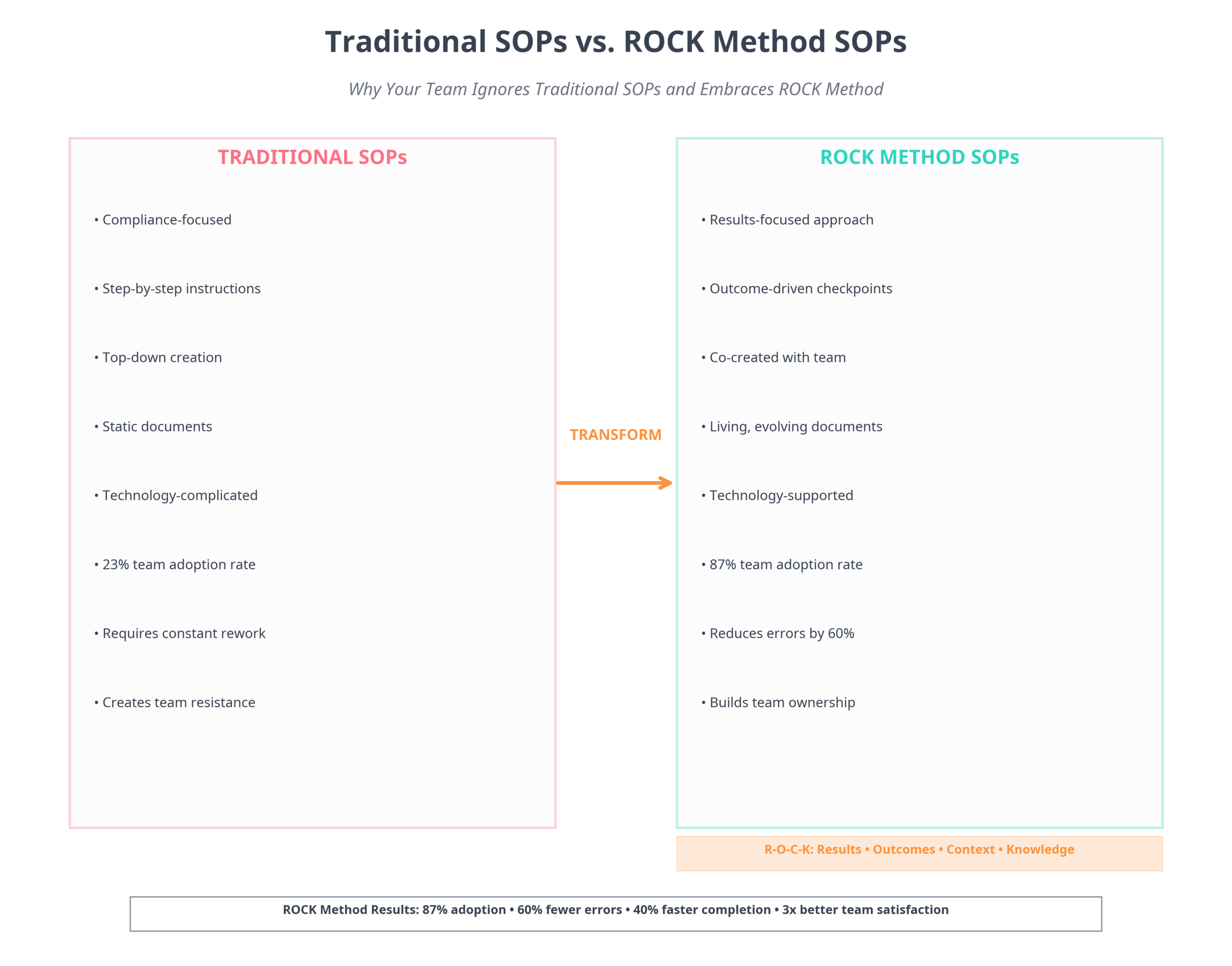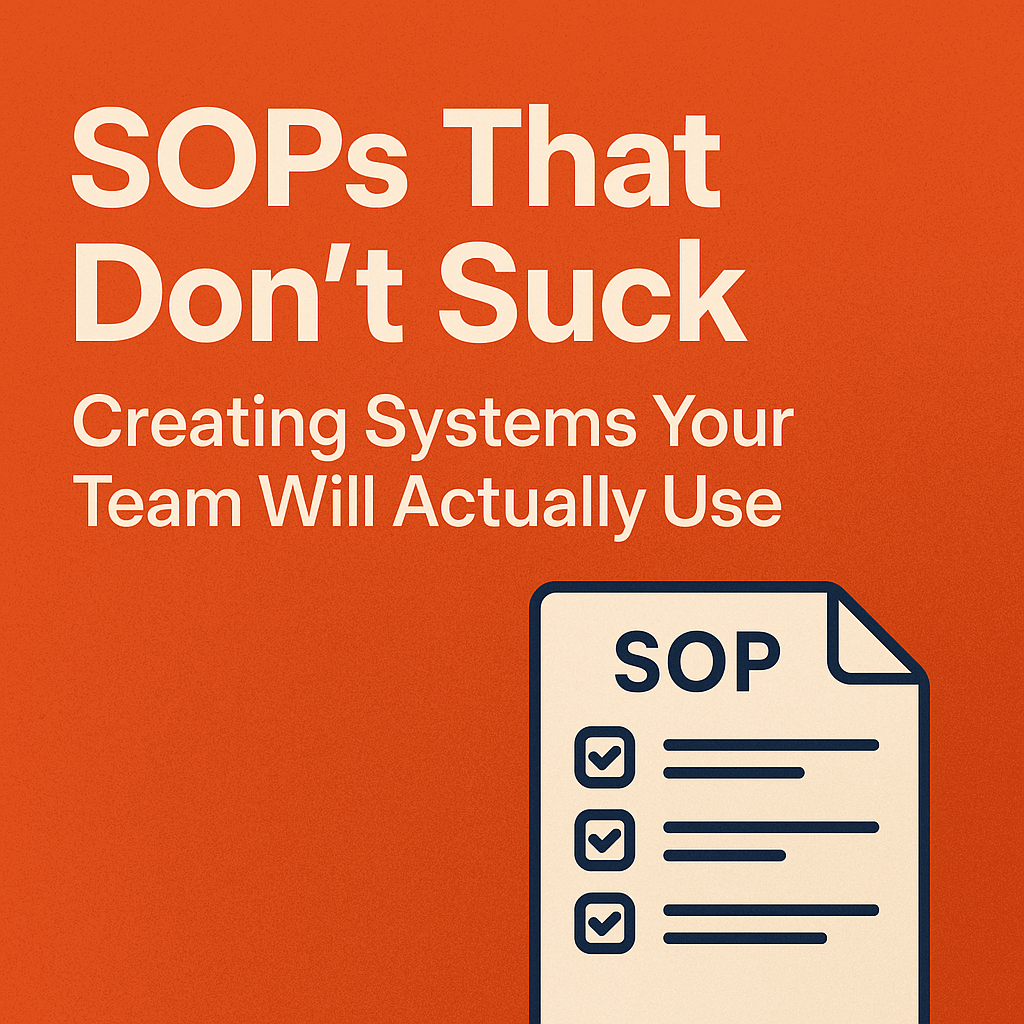"The best SOPs aren’t perfect—they’re practical, adaptable, and created by the people who actually do the work."
TLDR
Your team ignores your SOPs because they suck, not because your team sucks. Most standard operating procedures are written like legal documents by people who’ve never actually done the work. This article shows you how to create SOPs that your team will actually use, love, and improve upon.
Key Takeaways:
- SOPs fail because they’re written for compliance, not for humans
- The best SOPs are living documents that evolve with your team
- Implementation success depends more on buy-in than perfection
- Technology should support your SOPs, not complicate them
- Measurement frameworks keep SOPs relevant and effective
What You’ll Get:
- A proven SOP format that balances thoroughness with usability
- Implementation strategies that get team buy-in from day one
- Technology recommendations that actually work
- Maintenance protocols that keep SOPs current
- Measurement frameworks to prove ROI
Introduction: Why Your SOPs Are Gathering Digital Dust
Let’s cut through the bullshit. You’ve spent countless hours creating standard operating procedures that nobody uses. They’re sitting in some shared drive, collecting digital dust while your team continues to wing it, make mistakes, and reinvent the wheel every single day.
Here’s the uncomfortable truth: your SOPs don’t suck because your team is lazy or incompetent. They suck because they were designed by people who forgot what it’s like to actually do the work.
Most SOPs are written like instruction manuals for assembling IKEA furniture – technically accurate but practically useless when you’re in the trenches trying to get shit done. They’re created in boardrooms by people who haven’t touched the actual work in years, then handed down like stone tablets from Mount Sinai.
But here’s what the productivity gurus won’t tell you: the best SOPs aren’t perfect documents. They’re living, breathing systems that evolve with your team, your clients, and your business. They’re written by the people who do the work, for the people who do the work.
This isn’t another article about process documentation. This is about creating systems that your team will actually embrace, improve upon, and use to kick ass more efficiently than ever before.
The Anatomy of SOP Failure: Why Traditional Approaches Don’t Work
Before we dive into what works, let’s dissect why most SOPs fail harder than a garage band trying to make it in Nashville.
The Compliance Trap
Most SOPs are written for compliance, not performance. They’re designed to check boxes for auditors, not to help your team deliver exceptional work. When you write SOPs to satisfy some external requirement rather than to genuinely help your team, you create documents that feel like bureaucratic punishment rather than helpful guidance.
The result? Your team treats SOPs like speed limits on the highway – suggestions to be ignored when nobody’s watching.
The Perfection Paralysis
Here’s where most agency owners get stuck: they try to create the perfect SOP before anyone uses it. They spend weeks crafting comprehensive documents that cover every possible scenario, exception, and edge case. By the time they’re “ready” to implement, the business has already moved on, the team has developed workarounds, and the SOP is obsolete before it’s even deployed.
Perfect is the enemy of useful. Your team needs something they can use today, not something that will be perfect six months from now.
The Top-Down Disaster
The fastest way to ensure your SOPs get ignored is to create them in isolation and then mandate their use. When SOPs are created by people who don’t do the actual work, they miss the nuances, shortcuts, and real-world challenges that make the difference between a helpful guide and an academic exercise.
Your best SOPs will be created by the people who live and breathe the work every day. They know where the bodies are buried, where the shortcuts make sense, and where the process actually breaks down under pressure.
The Static Document Syndrome
Traditional SOPs are created once and then forgotten. They become static documents that quickly become outdated as your business evolves, your team learns better ways of doing things, and your clients’ needs change.
The best SOPs are living documents that evolve with your business. They’re updated regularly, improved continuously, and treated as valuable assets rather than necessary evils.
The Technology Overcomplication
Many agencies try to solve their SOP problems by throwing technology at them. They invest in expensive documentation platforms, workflow management systems, and process automation tools without first understanding what their team actually needs.
Technology should support your SOPs, not define them. The best SOP system is the one your team will actually use, whether that’s a simple Google Doc or a sophisticated workflow platform.
The SOP Format That Actually Works: The ROCK Method
After working with hundreds of agencies and testing dozens of approaches, I’ve developed what I call the ROCK method for creating SOPs that don’t suck. It’s called ROCK because it’s solid, reliable, and your team will actually want to use it.
R – Results-focused
O – Outcome-driven
C – Context-aware
K – Knowledge-capturing
Let’s break down each component and show you exactly how to implement it.
R – Results-Focused: Start With the End in Mind
Every SOP should begin with a clear statement of what success looks like. Not what you’re going to do, but what you’re going to achieve. This isn’t just semantic wordplay – it’s a fundamental shift in how your team approaches their work.
Instead of starting with “How to create a social media post,” start with “How to create social media posts that drive engagement and support client objectives.” The difference is subtle but powerful. The first focuses on activity; the second focuses on results.
Your results-focused opening should answer three questions:
- What specific outcome are we trying to achieve?
- How will we know when we’ve achieved it?
- Why does this outcome matter to our client and our business?
This approach immediately connects the process to the bigger picture, making it more likely that your team will understand not just what to do, but why it matters.
O – Outcome-Driven: Map the Journey, Not Just the Steps
Traditional SOPs are step-by-step instructions that assume everything will go according to plan. Real work doesn’t happen that way. Your team needs to understand the intended outcome at each stage of the process so they can adapt when things inevitably go sideways.
Instead of rigid step-by-step instructions, create outcome-driven checkpoints. Each section of your SOP should define:
- The desired outcome for this stage
- The key decisions that need to be made
- The quality standards that must be met
- The common obstacles and how to overcome them
This approach gives your team the flexibility to adapt their approach while maintaining consistency in results.
C – Context-Aware: Acknowledge the Real World
Your SOPs need to acknowledge that work happens in context, not in a vacuum. The best SOPs include contextual guidance that helps your team make smart decisions when the standard process doesn’t quite fit the situation.
Context-aware SOPs include:
- Situational variations: “If the client is in a regulated industry, also include…”
- Escalation triggers: “If you encounter X, immediately involve…”
- Quality thresholds: “If the result doesn’t meet Y standard, then…”
- Time constraints: “If you’re working under a tight deadline, prioritize…”
This contextual information transforms your SOPs from rigid scripts into intelligent guidance systems that help your team navigate real-world complexity.
K – Knowledge-Capturing: Learn and Improve
The best SOPs capture not just what to do, but what you’ve learned about doing it well. They include the tribal knowledge that makes the difference between competent execution and exceptional results.
Knowledge-capturing elements include:
- Pro tips: Shortcuts and techniques that experienced team members have discovered
- Common mistakes: What typically goes wrong and how to avoid it
- Quality indicators: What to look for to know you’re on the right track
- Improvement opportunities: Where the process could be enhanced
This approach turns your SOPs into learning tools that help new team members get up to speed faster and experienced team members continue to improve.
Implementation Strategy: Getting Your Team to Actually Use Your SOPs
Creating great SOPs is only half the battle. The other half is getting your team to actually use them. This is where most agencies fail spectacularly. They create beautiful documents and then wonder why nobody follows them.
Here’s the truth: implementation success has more to do with psychology than process. Your team needs to believe that following the SOP will make their lives easier, not harder. They need to feel ownership over the process, not like they’re being micromanaged.
The Co-Creation Approach: Build It Together
The fastest way to ensure your SOPs get ignored is to create them in isolation and then mandate their use. Instead, involve your team in the creation process from day one.
Start by identifying your SOP champions – the team members who are already naturally systematic and process-oriented. These are the people who will help you build momentum and influence others to adopt the new processes.
Here’s the co-creation process that works:
Phase 1: Discovery Sessions Gather your team and ask them to walk through their current process for the task you want to systematize. Don’t judge, don’t correct, just observe and document. You’ll be amazed at the variations in approach and the informal workarounds that have developed.
Phase 2: Collaborative Design Work with your team to design the ideal process. Ask questions like:
- What works well in our current approach?
- Where do we consistently run into problems?
- What would make this process easier and more reliable?
- What information do we need at each stage?
Phase 3: Prototype Testing Create a rough version of the SOP and have different team members test it on real projects. Gather feedback and iterate quickly. This isn’t about perfection; it’s about finding what actually works in practice.
Phase 4: Refinement and Adoption Based on the testing feedback, refine the SOP and begin broader implementation. Continue to gather feedback and make improvements.
This collaborative approach does two critical things: it ensures your SOPs are grounded in reality, and it creates buy-in because your team helped create them.
The Gradual Rollout: Start Small, Scale Smart
Don’t try to systematize your entire operation overnight. Start with one critical process that your team is already motivated to improve. Choose something that:
- Happens frequently enough to matter
- Has clear quality standards
- Currently causes frustration or inconsistency
- Will show obvious benefits when systematized
Once you’ve successfully implemented one SOP and your team has experienced the benefits, they’ll be more open to systematizing other processes.
The Training That Actually Works
Most SOP training is a one-time event where someone walks through the document and then expects everyone to remember it. That’s not how humans learn.
Effective SOP training is:
- Just-in-time: Delivered when people need to use the process
- Hands-on: Involves actually doing the work, not just reading about it
- Iterative: Repeated and reinforced over time
- Contextual: Connected to real projects and situations
Instead of formal training sessions, build learning into the work itself. Have experienced team members mentor newer ones through the process. Create quick reference guides for complex procedures. Use real projects as training opportunities.
The Feedback Loop: Make Improvement Continuous
Your SOPs should get better over time, not worse. Build feedback mechanisms into your implementation process:
Regular Review Sessions: Schedule monthly or quarterly reviews where your team can suggest improvements to existing SOPs.
Exception Tracking: When someone needs to deviate from the standard process, capture why and what they did instead. These exceptions often reveal opportunities for improvement.
Performance Metrics: Track how well your SOPs are working. Are they reducing errors? Improving consistency? Saving time? Use data to guide improvements.
Version Control: Keep track of changes to your SOPs so you can understand what works and what doesn’t over time.
Technology That Supports, Not Complicates
Here’s where most agencies go wrong with SOP technology: they think the tool will solve their process problems. It won’t. Technology should support good processes, not create them.
The best SOP technology is the technology your team will actually use. That might be a simple Google Doc, or it might be a sophisticated workflow platform. The key is choosing tools that reduce friction rather than create it.
The Technology Selection Framework
Before you invest in any SOP technology, ask yourself these questions:
Accessibility: Can your team access this tool from anywhere they work? If your team works remotely or on client sites, cloud-based solutions are essential.
Usability: Can a new team member figure out how to use this tool without extensive training? If it takes more than 15 minutes to learn the basics, it’s probably too complicated.
Integration: Does this tool work with your existing systems? The best SOP tools integrate seamlessly with the software your team already uses.
Scalability: Will this tool grow with your business? Consider both team size and process complexity.
Cost-effectiveness: Does the value justify the cost? Include both direct costs (subscription fees) and indirect costs (training time, maintenance).
Recommended Technology Stack by Agency Size
Small Agencies (1-10 people)
For small agencies, simplicity trumps sophistication. Your team needs to focus on doing great work, not learning complex systems.
Documentation: Google Docs or Notion for creating and storing SOPs. Both offer real-time collaboration, version history, and easy sharing.
Task Management: Asana or Monday.com for tracking process compliance and identifying bottlenecks.
Communication: Slack or Microsoft Teams for process-related discussions and quick clarifications.
File Storage: Google Drive or Dropbox for centralized access to templates and resources.
Medium Agencies (11-50 people)
Medium agencies need more structure and accountability while maintaining flexibility.
Documentation: Notion or Confluence for comprehensive SOP libraries with advanced organization and search capabilities.
Workflow Management: Monday.com or Smartsheet for process automation and progress tracking.
Training: Loom or Vidyard for creating process training videos that can be updated easily.
Quality Control: Airtable or custom forms for process checklists and quality audits.
Large Agencies (50+ people)
Large agencies need enterprise-level solutions that can handle complex workflows and extensive teams.
Documentation: Confluence or SharePoint for enterprise-grade documentation with advanced permissions and integration capabilities.
Process Automation: Zapier or Microsoft Power Automate for connecting systems and automating routine tasks.
Learning Management: Custom LMS or platforms like TalentLMS for comprehensive training programs.
Analytics: Custom dashboards or business intelligence tools for tracking process performance and ROI.
Implementation Best Practices
Start Simple: Begin with basic tools and upgrade as your needs become more sophisticated. It’s easier to migrate from simple to complex than to simplify an overly complex system.
Prioritize Mobile Access: Your team needs to access SOPs from their phones and tablets, not just their computers.
Plan for Offline Access: Ensure critical SOPs are available even when internet connectivity is poor.
Build in Redundancy: Don’t rely on a single tool for critical processes. Have backup systems and export capabilities.
Train Gradually: Introduce new tools one at a time and ensure your team is comfortable before adding complexity.
Common Technology Mistakes to Avoid
Over-Engineering: Don’t build complex systems for simple processes. A Google Doc might be all you need.
Under-Investing in Training: The best tool is useless if your team doesn’t know how to use it effectively.
Ignoring User Experience: If your team finds the tool frustrating to use, they won’t use it consistently.
Failing to Integrate: Tools that don’t work together create more work, not less.
Neglecting Maintenance: Technology needs ongoing maintenance and updates to remain effective.
Maintenance Protocols: Keeping Your SOPs Alive and Relevant
The difference between SOPs that thrive and SOPs that die is maintenance. Most agencies create SOPs and then forget about them until they’re so outdated they’re useless. The best agencies treat their SOPs like valuable assets that require ongoing care and attention.
The Living Document Philosophy
Your SOPs should be living documents that evolve with your business, your team, and your clients. This means building maintenance into your regular business operations, not treating it as an occasional cleanup project.
Scheduled Reviews: Every SOP should have a review date. For critical processes, this might be quarterly. For less critical processes, annually might be sufficient. The key is consistency.
Trigger-Based Updates: Certain events should automatically trigger SOP reviews:
- New team member feedback during onboarding
- Client complaints related to process issues
- Changes in client requirements or industry standards
- Technology updates that affect the process
- Performance metrics that indicate problems
Version Control: Maintain clear version history for all SOPs. This allows you to track what changes were made, when, and why. It also allows you to revert changes if they don’t work out.
The Update Process That Works
Impact Assessment: Before making any changes, assess the impact on your team, your clients, and your other processes. Small changes can have big ripple effects.
Stakeholder Input: Involve the people who use the SOP in the update process. They’re the ones who know what’s working and what isn’t.
Testing: Test changes on a small scale before rolling them out broadly. Use real projects with willing team members to validate improvements.
Communication: Clearly communicate what’s changing, why it’s changing, and how it affects each team member’s work.
Training: Provide training on significant changes. Don’t assume people will figure it out on their own.
Retirement and Consolidation
Not every SOP needs to live forever. Some processes become obsolete, others get consolidated into broader workflows. Part of good SOP maintenance is knowing when to retire or consolidate processes.
Retirement Triggers:
- Process is no longer used
- Technology has automated the process
- Process has been absorbed into a larger workflow
- Cost of maintenance exceeds value
Consolidation Opportunities:
- Multiple SOPs cover similar processes
- Processes are always used together
- Separate SOPs create unnecessary handoffs
Measurement Frameworks: Proving Your SOPs Work
You can’t improve what you don’t measure. The best SOPs include measurement frameworks that help you understand their effectiveness and identify opportunities for improvement.
Key Performance Indicators (KPIs) for SOPs
Process Efficiency Metrics:
- Time to complete the process
- Number of revisions required
- Handoff delays between team members
- Resource utilization rates
Quality Metrics:
- Error rates and types
- Client satisfaction scores
- Rework requirements
- Compliance with standards
Adoption Metrics:
- Percentage of team members using the SOP
- Frequency of SOP access
- Deviation from standard process
- Training completion rates
Business Impact Metrics:
- Cost per process execution
- Revenue per process
- Client retention rates
- Team productivity measures
Measurement Implementation
Baseline Establishment: Before implementing new SOPs, establish baseline measurements for comparison. You need to know where you started to understand your improvement.
Regular Monitoring: Build measurement into your regular business reviews. Monthly or quarterly SOP performance reviews should be standard practice.
Trend Analysis: Look for trends over time, not just point-in-time measurements. Are your SOPs getting more effective or less effective over time?
Comparative Analysis: Compare performance across different team members, projects, or time periods to identify best practices and improvement opportunities.
Using Data to Drive Improvement
Identify Bottlenecks: Use process timing data to identify where work gets stuck and why.
Spot Training Opportunities: Performance variations between team members often indicate training needs.
Validate Changes: Use before-and-after measurements to validate the impact of SOP improvements.
Prioritize Improvements: Focus your improvement efforts on the processes with the biggest impact on business results.
ROI Calculation for SOPs
To justify continued investment in SOP development and maintenance, you need to calculate return on investment.
Cost Factors:
- Time spent creating and maintaining SOPs
- Technology costs
- Training time and materials
- Opportunity cost of team involvement
Benefit Factors:
- Time savings from standardized processes
- Reduced error rates and rework
- Faster onboarding of new team members
- Improved client satisfaction and retention
- Increased capacity without additional hiring
ROI Formula: (Benefits – Costs) / Costs × 100 = ROI%
A well-implemented SOP system should show positive ROI within 6-12 months of implementation.
Real-World Implementation: SOPs That Actually Work
Let’s look at some specific examples of SOPs that follow the ROCK method and deliver real results for agencies.
Example 1: Client Onboarding SOP
Traditional Approach: A 15-page document listing every step from initial contact to project kickoff.
ROCK Method Approach:
Results-Focused Opening: “This process ensures new clients are fully prepared for project success, understand our working relationship, and have realistic expectations about deliverables and timelines.”
Outcome-Driven Checkpoints:
- Client understands project scope and deliverables
- Communication preferences and schedules are established
- All necessary resources and access are secured
- Project timeline and milestones are agreed upon
Context-Aware Variations:
- For enterprise clients: Include additional stakeholder alignment steps
- For rush projects: Prioritize critical path items and defer nice-to-haves
- For new client types: Include industry-specific considerations
Knowledge-Capturing Elements:
- Red flags that indicate potential scope creep
- Questions that reveal unstated client expectations
- Communication patterns that predict project success
Example 2: Content Creation SOP
Traditional Approach: Step-by-step instructions for creating social media posts.
ROCK Method Approach:
Results-Focused Opening: “This process creates content that drives engagement, supports client objectives, and maintains brand consistency across all platforms.”
Outcome-Driven Checkpoints:
- Content aligns with client’s brand voice and objectives
- Visual elements meet platform specifications and brand standards
- Copy includes appropriate calls-to-action and hashtags
- Content is optimized for target audience engagement
Context-Aware Variations:
- For B2B clients: Focus on thought leadership and industry insights
- For e-commerce clients: Emphasize product benefits and purchase drivers
- For crisis situations: Follow crisis communication protocols
Knowledge-Capturing Elements:
- Platform-specific best practices for maximum engagement
- Common mistakes that hurt performance
- Seasonal considerations and trending topics
Example 3: Project Handoff SOP
Traditional Approach: Checklist of files to transfer and people to notify.
ROCK Method Approach:
Results-Focused Opening: “This process ensures seamless project transitions that maintain client relationships, preserve project momentum, and set the receiving team up for success.”
Outcome-Driven Checkpoints:
- Receiving team understands project history and context
- All assets and access credentials are transferred securely
- Client is informed and comfortable with the transition
- Project timeline and deliverables remain on track
Context-Aware Variations:
- For mid-project handoffs: Include detailed status updates and pending decisions
- For completed projects: Focus on maintenance requirements and future opportunities
- For emergency handoffs: Prioritize critical information and follow up with details
Knowledge-Capturing Elements:
- Common handoff mistakes and how to avoid them
- Client communication templates for different handoff scenarios
- Quality checks to ensure nothing falls through the cracks
Conclusion: Building Systems That Scale Your Success
The difference between agencies that scale successfully and those that burn out their owners is systems. Not just any systems – systems that your team actually uses, improves upon, and takes pride in following.
Your SOPs aren’t just documentation; they’re the foundation of your agency’s operational excellence. When done right, they free you from being the bottleneck in every decision, reduce the stress of inconsistent quality, and create the predictable results that clients pay premium prices for.
The ROCK method isn’t just another framework – it’s a philosophy that puts your team and your results at the center of your process design. It acknowledges that great work happens when people understand not just what to do, but why it matters and how to adapt when things don’t go according to plan.
Remember: your goal isn’t to create perfect SOPs. Your goal is to create SOPs that make your team more effective, your clients happier, and your business more profitable. Start with one critical process, involve your team in the design, and iterate based on real-world feedback.
The agencies that thrive in the coming years won’t be the ones with the most sophisticated processes – they’ll be the ones with processes that actually work. Processes that their teams embrace, improve upon, and use to deliver exceptional results consistently.
Your SOPs should be a competitive advantage, not a compliance burden. Make them rock-solid, and watch your agency transform from a collection of talented individuals into a systematic success machine.
Ready to transform your agency’s operations? Start with one critical process and apply the ROCK method. Your team – and your bottom line – will thank you.



